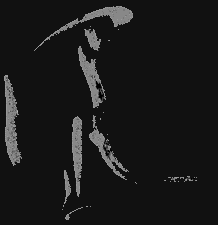Naoki Kimura
Moved to the U.S. in 1987, based in New York and Tokyo (2017-).
The main focus is on original prints specializing in monochrome.
He has produced a number of photographic art works based in Europe.
While searching for a taste rooted in harmony and the beauty of things, which he calls "Nagi"-Mono no aware-, he captures the "Fluctuation" and its texture - qualia - that stand at the intersection of time and space.
Kimura's work over that last few years has moved in a more honed direction to acquire a depth and solemnity works, which have been succeeded even to works in Japan as setting for his subject, that has found a devoted audience among US and Euro collectors.
Biography
Naoki Kimura was born during the period of rapid economic growth in Japan, a country that had achieved a remarkable recovery, symbolized by the holding of the Tokyo Olympics, and had made a full-scale return to international society.
He spent his childhood in Nishijin, Kyoto, in a climate of mixed tradition and innovation, which can be said to have formed the basis of his sensitivity to the gradual gradation of “Qualia-texture”. In the spring of his fifteenth year, he visited a photo exhibition of works by deaf people and was inspired by the power of photographs to speak "eloquently", and clearly remembers that choosing photography as a way to express his sensitivity.
While groping in the dark to become a photographer, he moved to Tokyo to enroll in a college of photography, and went on to study at a university to major in aesthetics and art history while trying to figure out what the art of photography was. He also intended to study at a graduate school, and moved to the U.S. to expand his horizons.
This series of schooling experiences is similar to what is called "gap year" behavior in Europe and the United States, and can be said to have been part of the elements of photographic expression.
In 1990, after receiving the blessing of an art gallery in New York, he went to Italy, where his soul's desire was to create works. It was the beginning of experiencing and affirming his instinctive and natural response to what he perceives as "beautiful.
The underlying concept of Kimura's work is what he calls "Nagi-Lull," an ambiguous sense of "fluctuation" that "people" possess. Kimura's "Nagi-Lull" has the meaning of a medium for the primitive "human" sensibility of experiencing "fluctuation" with "Qualia-texture".
The common human sense of "beauty" is generally instinctive, and this is one of the themes of Kimura's works, which speak to us through their unique texture, similar to empathy.
In expressing his mental landscape, all of his works are unified by monochrome expression, The documentary nature of photography, which is essentially a record of reality, captures the fragmented nature of reality but not reality itself. There is a sense in which the elimination of "color" makes it clear that the work is not reality (real).
Furthermore, it is the soul's choice of desire for a paradigm shift in which space is abstracted in the act. of monochromatization.
His works are mainly based on the medieval and renaissance period when he confronted his subjects in Europe, mainly in Italy, seeking a sense of atmosphere, which has been his lifework since the beginning of his career.
In addition, in recent years (since 2015), by looking at subjects in Japan, He has been attempting to express himself in a way that allows him to flexibly surrender his sensitivity to his own innate "Qualia-texture".
“Nagi" exists firmly in Kimura's mind, and it is a "fluctuation" that surely exists as a qualia-texture for those who see it.
There is no longer any hesitation in seeking pure and simple expression through an approach to the roots of humanity, born from the concept of "marginal art" originating in Japan.
Naoki Kimura is an artist who describes the photographs as "beautiful”.

